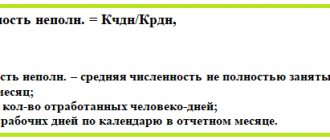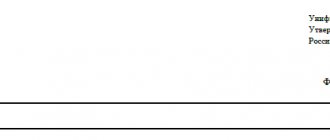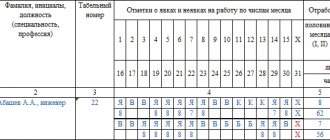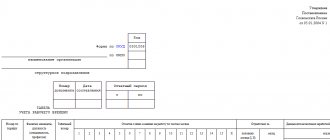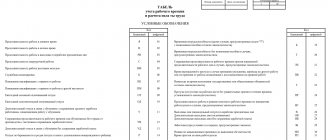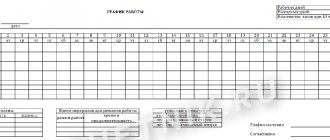What is a timesheet and why do you need to record time worked?
According to the standards, the obligation to maintain a time sheet is established by Resolution of the State Statistics Committee dated January 5, 2004 No. 1. The document helps the personnel service and accounting department of the enterprise:
- take into account the time worked or not worked by the employee;
- monitor compliance with the work schedule (attendance, absence, lateness);
- have official information about the time worked by each employee for calculating wages or compiling statistical reporting.
It will help the accountant confirm the legality of accrual or non-accrual of wages and compensation amounts for each employee. The HR officer must track attendance and, if necessary, justify the penalty imposed on the employee.
It is worth noting that the unified forms of report cards No. T-12 and No. T-13 are not required for use from 01/01/2013. But employers are required to keep records (Part 4 of Article 91 of the Labor Code of the Russian Federation). Organizations and individual entrepreneurs have the right to use other methods of monitoring the time employees spend at work. But in fact, the form format developed by Goskomstat is quite convenient and continues to be used everywhere.
Who is responsible for recording time worked in the organization?
According to the instructions for using and filling out forms of primary accounting documents:
- the working time sheet is compiled and maintained by an authorized person;
- the standards indicate who signs the time sheet - the head of the department and the HR employee;
- after which it is transferred to the accounting department.
Management has the right to appoint anyone to perform this task. To do this, an order is issued indicating the position and name of the responsible person. If an order to appoint such an employee is not issued, then the obligation to keep records is specified in the employment contract. Otherwise, it is unlawful to require an employee to keep records. In large organizations, such an employee is appointed in each department. He fills out the form within a month, gives it to the head of the department for signature, who, in turn, checks the data and passes the form to the personnel officer. The HR department employee verifies the information, fills out the documents necessary for his work based on it, signs the time sheet and passes it on to the accountant.
In small companies, such a long chain is not followed - maintaining time sheets for employees is entrusted to the personnel employee, and he submits the completed document to the accounting department on a monthly basis.
What is the difference between forms No. T-12 and No. T-13
The two approved forms differ in that one of them (T-13) is used in institutions and companies where a special turnstile is installed - an automatic system that controls the attendance of employees. And the T-12 form is universal and contains, in addition, an additional section 2. It reflects settlements with employees for wages. But if the company conducts settlements with personnel as a separate type of accounting, section 2 simply remains empty.
ConsultantPlus experts discussed how to keep track of working hours. Use these instructions for free.
Step-by-step filling instructions
Two rules apply for filling out a time sheet, the choice is made by the employer:
- continuous filling - all appearances and absences are recorded every day;
- filling in by deviations - only lateness and no-shows are noted.
Here are instructions on how to keep a time sheet manually - for the T-13 form using the continuous filling method.
Step 1. Name of the organization and structural unit
At the top, enter the name of the company (full name, individual entrepreneur) and the name of the structural unit: for example, sales department, marketing department, production department, etc.
Step 2. OKPO code
OKPO - All-Russian Classifier of Enterprises and Organizations. Contained in Rosstat databases, it consists of:
- 8 digits - for legal entities;
- 10 digits - for individual entrepreneurs.
Step 3. Document number and date of preparation
The document number is assigned in order.
The compilation date is usually the last day of the reporting month.
Step 4. Reporting period
The report card is submitted per month - the period from the first to the last day of June in our case.
Step 5. Employee information
A separate line is filled in for each department employee. Indicate the serial number, surname and position of the employee.
A personnel number is assigned to each employee and is used in all internal accounting documents. It is retained by the employee for the entire period of work in the organization and is not transferred to another person for several years after dismissal.
Step 6. Information about attendance and number of hours
Abbreviated symbols are used to fill out information about employee attendance and absence. You will find a list of them at the end of the article in a separate paragraph. In our example for employee Petrov A.A. 4 abbreviations used:
- I - attendance (in case of attendance, the number of hours worked is recorded in the bottom cell);
- On a weekend;
- K - business trip;
- OT - vacation.
Step 7. Total number of days and hours for the month
Here's how to correctly count hours on an organization's time sheet:
- in the 5th column indicate the number of days and hours worked for every half month;
- in the 6th column - the total number of days and hours for the month.
Step 8. Payroll information
The payment type code determines the specific type of cash payment, encrypted in numbers. For a complete list of codes, see the end of the article. The example uses:
- 2000 - salary (wages);
- 2012 - vacation pay.
Corresponding account is an accounting account from which costs for a specified type of remuneration are written off. In our case, the account for writing off salaries, travel allowances and vacation pay is the same.
Column 9 indicates the number of days or hours worked for each type of remuneration. In our case, the days of attendance and business trips are entered in the top cell, and the days on vacation are entered in the bottom cell.
If one type of remuneration (salary) is applicable to all employees during the month, then the code of the type of payment and the account number are written at the top, columns 7 and 8 are left empty, indicating only the days or hours worked in column 9. Like this:
Step 9. Information about the reasons and time of absence
Columns 10-12 contain the code for the reason for absence and the number of hours of absence. In our example, the employee was absent for 13 days:
- 3 days - due to a business trip;
- 10 days on vacation.
Step 10. Signatures of responsible persons
The report card is signed at the end of the month:
- employee responsible for maintenance;
- head of department;
- personnel worker.
Are hours entered on the timesheet when traveling on a business trip?
The time register according to the rules of maintenance is a simple document. When filling it out, it is important to pay attention to detail and reflect all information.
As well as the employees themselves, they must understand the rules for calculating their salaries and maintaining paperwork in order to provide the necessary documentary evidence - memos about working at night, sick leave, submitting a travel certificate and an advance report on time.
Business trip in timesheet sample download
Business trip day – K, is considered as a full working day, including taking into account travel and downtime. Therefore, when summing up the total hours in the timesheet, these days must be counted as full working days.
Download a sample of filling out a timesheet with travel days
An employee’s stay on a business trip must be recorded in the work time sheet, without which it will be difficult to prove the work trip and calculate wages. The designation of a business trip in the time sheet must be done by the employer or an employee of the enterprise’s accounting department in accordance with Part 4 of Article 91 of the Labor Code of the Russian Federation.
You can find out how to mark a business trip on your report card by studying Article 91 of the Labor Code of the Russian Federation.
The time spent by an employee on a business trip cannot be designated either as working hours or as missed work days, so a business trip is usually designated with the special designation “K” .
In fact, a business trip can be defined as a work assignment not at the place of main work activity. In the timesheet, business trips must be separated into a separate category with a special designation.
Payment for the duration of a business trip is made according to the employee’s average earnings during the period spent on a business trip, so the number of hours worked by the employee does not need to be indicated.
However, if overtime hours were worked on a business trip, they must be paid additionally and are indicated in the timesheet by the abbreviation “KS” . In this case, it is necessary to indicate the number of hours worked in excess of the norm and pay them in accordance with the employee’s average hourly wage.
At the same time, just like during normal working hours, overtime hours must be paid in excess of the norm in accordance with the employment contract with employees and the Labor Code.
An employee may get sick even during a business trip and then he will have to take sick leave. The time spent on a business trip that a person spent on sick leave is not noted as regular business trip days, but has a special designation “K/B” . Payment for time spent on sick leave on a business trip is made based on the same principles as payment for regular sick leave.
If an employee is on sick leave during a business trip, the employer cannot oblige him to travel, but must assign the work to another employee.
However, on his own initiative, an employee can go on a business trip even while on sick leave if he writes a special statement.
If an employee voluntarily goes on a business trip while on sick leave, the days of sick leave during which he performed work duties are not paid, but only the days spent on a business trip are paid. An employer has no right to pay for the same working day twice.
Vacation notes
Before marking vacation on your time sheet, it is important to consider the following points:
- what type of leave to indicate;
- vacation period - from what date to what date the employee rests;
- what method is used to fill out the timesheet - continuous or only deviations are recorded?
Different types of leave are indicated by the following abbreviations:
| FROM | Another paid vacation |
| OD | Additional paid |
| BEFORE | Administrative (without saving salary) |
| U | Educational with salary retention |
| UV | On-the-job training (shortened day) |
| UD | Educational without saving salary |
| R | For pregnancy and childbirth |
| coolant | Child care up to 3 years old |
| OZ | Without saving the salary in cases provided for by law |
| DB | Additional without saving salary |
When using both methods of filling out a timesheet, a vacation symbol is affixed for each day the employee is absent. It’s just that when using the continuous method, the remaining days are filled with turnouts (conditional code “I”), and when using the deviation accounting method, they remain empty.
Truancy
Absenteeism may become one of the grounds for terminating an employment agreement at the request of the employer.
Absenteeism is the absence of an employee from his assigned place without a satisfactory reason for 4 or more hours in a row during one day (shift). Nothing depends on the length of the shift (the employee skipped working hours). The boss can define the following points as absenteeism:
- When an employee who has signed an employment contract (term unspecified) leaves his workplace without satisfactory reason, without notifying the employer of termination of the agreement, before the expiration of the 2 week notice period;
- When an employee who has signed a contract (fixed term) leaves the position without any valid reason before the expiration of the contract or before the expiration of the warning period for early termination;
- Self-management of days off, as well as arbitrary assignment of vacation.
These norms may seem to be clearly defined and extremely transparent. However, employers, and often the courts, even today find themselves at a dead end when studying such cases and determining whether a particular situation constitutes truancy. As a result, judges' verdicts often turn out to be incorrect and hasty.
Other designations and codes
We present the letter designations used in the time sheet in the form of tables.
Presence at the workplace:
| I | Daytime work |
| N | At night time |
| RV | Work on weekends and holidays (used if the employee goes to work on days declared non-working due to quarantine |
| WITH | Overtime |
| VM | On a rotational basis |
IMPORTANT!
Remote and remote work is marked in the report card with the same symbols as regular work. If a remote employee has worked full time, indicate I (or 01 if indicated digitally) on the top line, and the number of hours actually worked according to the standard working time on the bottom line.
Business trips and advanced training:
| TO | Business trip |
| PC | Off-the-job training |
| PM | Advanced training with a break from work in another area |
Absence from work:
| B | Temporary disability (sick leave) with payment of benefits (also used if the employee is in quarantine) |
| T | Temporary disability without payment of benefits |
| Champions League | Shortened working hours in cases provided for by law |
| PV | Forced absenteeism due to illegal removal (dismissal) |
| G | Failure to appear in connection with the performance of state (public) duties |
| ETC | Absenteeism without good reason |
| NS | Part-time mode |
| IN | Weekends and holidays are non-working days (also included in cases where non-working days are established due to quarantine) |
| OB | Additional paid time off |
| NV | Additional unpaid day off |
| ZB | Strike |
| NN | Unexplained reason for no-show |
| RP | Downtime due to the employer's fault |
| NP | Downtime due to reasons beyond anyone's control |
| VP | Downtime due to employee fault |
| BUT | Suspension from work (paid) |
| NB | Disqualification without retention of salary |
| NZ | Suspension of work when a salary is delayed |
IMPORTANT!
If an employee goes to work on days declared by the president as non-working days due to the coronavirus quarantine (03/30-04/03/2020), it is recommended to enter the PB code in the timesheet indicating the hours worked.
We present only the main digital codes of types of remuneration (the full list is in the order of the Federal Tax Service of Russia dated October 13, 2006 No. SAE-3-04 / [email protected] ):
| 2000 | Labor payments (salary, remuneration) |
| 2010 | Payments under civil contracts |
| 2012 | Vacation pay |
| 2300 | Sickness benefit |
| 2530 | Payment in kind |
| 2760 | Financial assistance upon dismissal and retirement |
| 3020 | Interest on deposits |
Selected cases of tabulation
When filling out a timesheet, it is necessary to correctly display data on night hours, time off, absenteeism, vacations, and even dismissal. In order not to get confused with a large amount of information, we will consider each case separately.
Night hours
In Art. 96 of the Labor Code of the Russian Federation states that night work is the period from 22:00 to 06:00 local time. It can be of two types:
- ordinary (the employee is scheduled to go on the night shift or works according to the “every three days” scheme);
- overtime.
In the first case, the code “N” or “02” is indicated in the timesheet, and in the second, it is indicated through a fraction that the work was overtime (a separate line can be used for this purpose).
The timesheet rules prohibit excluding required fields, but allow you to enter additional items.
Time off
In modern labor legislation there is no such concept as “time off”.
It was inherited from Soviet times and was used in the Labor Code, which was in force with changes until 2002. In the current Labor Code of the Russian Federation, other terms are used - additional rest time, another day of rest, etc. So, in fact, time off is preserved, but different wording is used to designate it. Time off is granted in different cases:
- when donating blood;
- when working overtime, etc.
- to compensate an employee for performing work duties on weekends or other non-working days (instead of an additional day off, the employer may offer the employee increased pay);
Time off is not provided to those who work under a fixed-term contract lasting less than 2 months, so they can only qualify for increased pay.
So, in the time sheet, time off can be indicated under different codes:
- work on weekends/non-working days/holidays – “РВ”, “03”;
- forced time off upon reinstatement at the previous place of work - “PV”, “22”;
- paid time off – “OV”, “27”;
- unpaid time off – “NV”, “28”.
Absenteeism
This is the time when the employee was not at work. Depending on the reason for absence, the code to be entered into the timesheet is determined:
- absenteeism without a good reason - “PR”, “24”;
- absenteeism for unknown reasons – “NN”, “30”.
It should be borne in mind that the second code is used temporarily - until the circumstances of absenteeism are clarified. If the reason is subsequently recognized as valid, then a corrective report card is drawn up indicating a different code.
Absenteeism may not last the entire working day, but several hours.
In this case, it is reflected in the timesheet using a special method: in the corresponding cell, two codes are indicated through a fraction - absence and actual work. The fact is that the employee must receive payment for the hours worked, even if he was absent from work for more than 4 hours, for which he can be fired in accordance with paragraph “a” of Part 6 of Art. 81 Labor Code of the Russian Federation. Finally, you should pay attention to the typical mistake that many timekeepers make when marking with an absenteeism code the time when the employee was absent from work due to administrative detention or being in custody. This happens against his will, therefore it is not considered absenteeism without a good reason, although it is not paid by virtue of Art. 129 Labor Code of the Russian Federation. In this case, the most acceptable code is “NN” or “30”.
Vacation
There are different codes for designating leave, the choice of which depends on the type of leave and its duration. Here are all the possible options:
- annual paid leave – “FROM”, “09”;
- annual additional paid leave – “OD”, “10”;
- leave for an employee who combines work and study - “U”, “11”;
- leave for a student without pay – “UD”, “13”;
- maternity leave, pregnancy leave, adoption of a newborn - “P”, “14”;
- leave to care for a child up to 3 years old – “OZH”, “15”;
- leave at your own expense with the permission of the employer - “DO”, “16”;
- leave without pay, granted in cases provided for by law - “OZ”, “17”;
- daily additional leave without pay – “DB”, “18”.
If the time sheet is filled out using the continuous method, the vacation symbol is indicated for each day the employee is absent, and if using the deviation method, the cells are left empty. In this case, not only working days are filled, but also weekends falling during the vacation period, since vacation pay is accrued for calendar days. However, holidays and non-working days that fall during the vacation period must be underlined or left blank.
Business trip
During a business trip, an employee receives payment for all working days according to the company’s schedule, so during this period, working hours should be displayed in this way:
- in the top line, enter the number of hours worked according to the company’s work schedule (for example, 8 hours), regardless of how many hours the employee actually worked at the place of business trip;
- in the bottom line indicate the designation of the business trip (business trip - “K”, “06”).
If the day of the business trip falls on a weekend, then you can put a dash in the top cell, and the corresponding code in the bottom. If the employee was specially sent on a business trip on his day off, then in the top line you need to indicate the number of hours he worked, and in the bottom line, separated by a fraction, the codes “РВ”/“К” or “03”/“06” (hours on weekends and holidays) days / business trip).
Dismissal
HR officers doubt whether it is worth celebrating the dismissal of an employee in the middle of the month and in the following days, when he is no longer on the payroll.
There are no notes on this matter in the regulatory documents, but from the contents of the resolution of the State Statistics Committee of the Russian Federation No. 1 of 01/05/2004 it follows that the last working day of an employee can be designated by the appearance code “I” or “01”, but provided that it was fully worked . The days following dismissal do not need to be designated in any way - the employee has already been excluded from the company’s staff, so there is no need to keep records of his working time. Meanwhile, in order to eliminate the possibility of future forgeries or erasures, it is better to put dashes in empty cells.
